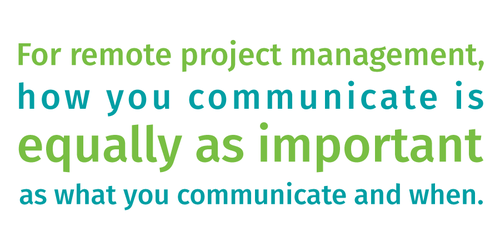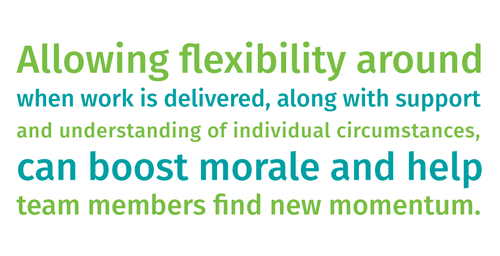Blog
< Back to Blogs
A Guide to Managing Project Resources Remotely

Remote project management has been gaining in popularity in recent years, and the emergence of new project management software, video conferencing and instant messaging apps, and high-speed internet have all contributed to the rise and feasibility of remote teams. For some Project Managers, leading virtual teams is their speciality; for others, the restrictions imposed by COVID-19 may be providing them with their first taste of remote project work.
For those who fall into the latter category, we’ve put together some top tips on how to manage project resources remotely. Certain points may be obvious to the experienced Project Manager – there is, after all, considerable overlap between managing people virtually and in the office. If you’re new to remote, however, this short guide may provide some useful issues to consider as you navigate unchartered territory.
Communication is Key
It will come as no surprise to find communication in our number one spot. Good, regular communication is at the heart of effective project management from kick-off through to completion. Weekly meetings, monthly reviews and email updates all help to keep people on the same page, on track and working towards the same end goals.
For remote project management, how you communicate is equally as important as what you communicate and when. What video conferencing app(s) are you going to use? What instant messenger service will you choose to replace the impromptu chats over coffee in the office? How will you provide project visibility to everyone involved? There will no doubt be many questions to discuss and resolve before you find the best format for your team.

Encourage Open Discussion of Issues
When leading remote teams, it can be challenging to stay on top of issues that may affect the successful outcome of the project. As we’ve mentioned, communication is obviously key; so, too is the ability to encourage all team members to speak up – and speak early – about anything that is troubling them. Some individuals will likely be more forthcoming than others. We suggest that Project Managers ensure that every person has their say during or after team meetings and reviews.
Platforms such as Slack, Flock or Microsoft Teams can also provide useful forums for discussion. Another option to consider is regular one-on-one chats with individuals, where they have a chance to voice their opinions and concerns in private with you.
Monitor Progress and Provide Feedback
Even with geographically dispersed teams, a Project Manager can see what individual team members are working on and how they are progressing. A project management platform is an obvious must and you may also want to consider optional activity monitoring features. Regular project snapshots and data can provide invaluable insights into individual and team progress and ensure you can intervene to resolve any issues before they escalate. Some of the most widely used tools to consider include Basecamp, Trello, Teamwork Projects and Asana.

Allow Scope for Flexibility
These are unprecedented times and we know remote Project Managers will be aware of the need for flexibility. Even the most motivated and dedicated team members may struggle to make calls and meet deadlines when they are working from home. They may need to suddenly absent themselves from a video conference to deal with their daughter’s Lego or to quieten a barking dog. They may work at random hours of day and night to complete the tasks assigned to them. Allowing flexibility around when work is delivered, along with support and understanding of individual circumstances, can boost morale and help team members find new momentum.
Summary
Managing project resources remotely can pose challenges, especially to those unused to working with dispersed teams. By promoting regular communication across multiple channels while paying close attention to tracking individual and team progress, Project Managers can ensure maximum efficiency and success. In the current situation, flexibility is also a key consideration, making allowances for individual circumstances and providing support where needed.
For more advice on remote project management or to discuss the opportunities we currently have available, contact the IT recruitment specialists at Enterprise IT Resources today.

Share This Article
Recent Articles


Filter By Category
Subscribe to our News & Advice
We will get back to you as soon as possible.
Please try again later.





All content copyrighted Enterprise IT Resources © All rights reserved | Privacy Policy | Collection Statement | Powered with 💚 by Shazamme









